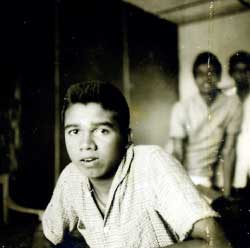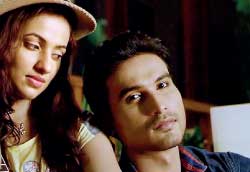Reply To:
Name - Reply Comment
Last Updated : 2024-04-23 12:32:00

 “When movies, the only art which everyone felt free to enjoy and have opinions about, lose their connection with song and dance, drama, and the novel, when they become cinema, which people fear to criticise just as they fear to say what they think of a new piece of music or a new poem or painting, they will become another object of academic study and ‘appreciation’, and will soon be an object of excitement only to practitioners of the ‘art’.” (Pauline Kael)
“When movies, the only art which everyone felt free to enjoy and have opinions about, lose their connection with song and dance, drama, and the novel, when they become cinema, which people fear to criticise just as they fear to say what they think of a new piece of music or a new poem or painting, they will become another object of academic study and ‘appreciation’, and will soon be an object of excitement only to practitioners of the ‘art’.” (Pauline Kael)
There is a young man whom I know, pretty much like the young man from last week’s piece, who is into Sinhala movies. I met him quite by accident, I didn’t know of his existence until he began besieging me with one query after another, and about two months after we made our first acquaintance, it’s safe to say that I have not come across a person that age who is so enthusiastic about our cinema. Now I don’t know much about him, except his name (which I won’t divulge) and his home town (which doesn’t matter). He has his views and opinions on the movies and all guesses are that they don’t coincide with mine. For the record, they don’t.
Where we agree with each other, however, is the point that for our movies to evolve, the dichotomy between what is arty and what is commercial must be done away with.
None of our directors, and none of our films, could be considered as perfect. The same could be said of directors and films from elsewhere from other industries. Even those which (and who) top those greatest ever lists – and there hasn’t been a lack of them here or there, then or now – aren’t really flawless. What is good and bad and pedestrian, as I implied earlier, depends on the values a critic or an audience ascribes to them. The problem isn’t that what is good for me may not be good for you. Rather, the problem is that when it comes to our film industry, the critics more often than not define good and bad and draw an artificial barrier between the two.
Such a barrier thrives in the long term on that equally deplorable barrier between ‘High Art’ and ‘Low Art’. On that basis, some movies are praised while others are neglected. Nidhanaya was Art, for instance, while Kawuda Raja was not. Lester James Peries is the epitome of good cinema, while K. A. W. Perera is at best a storyteller, a magician. In another country, being a magician might have been enough for an aspiring director, but in Sri Lanka, the evolution of our cinema has been from the French to East Europeans. Any director who treads beyond these two is hailed as a magician, a middle-of-the-road cineaste. But a serious film maker he/she is not.
I am not saying Kawuda Raja is a great work of art. It’s not art, but it’s not ‘Low Art’ either. And I am not saying that K. A. W. Perera was a great director. But just the other day I was watching Janaka Saha Manju (for the third or fourth time, I can’t remember) and I was wondering why, when our hero meets his lover for the first time, Manju was clutching a doll for no comprehensible reason. Then it hit me: the fact that I was entranced by their conversation and everything which followed, despite the absurdity of it all, meant that Perera had done something which none of those who venerate ‘High Art’ could or can do. Keep me intrigued.
When the movies become cinema, i.e. something to be intellectualised, critics don’t know what to praise and what to dislike, or for that matter the criterion one uses to do that. When we are made to appreciate a movie by the fact of its being serious, arty, controversial, you-name-it, we don’t really react to it. I am not entirely sure whether we need to appreciate a work of art, come to think of it. If appreciation is all it took for a movie to prosper, whether at the box-office or with the critics, and if appreciation can be falsified or faked, then what can one hope for in our industry?
I suppose this could explain to a considerable extent at least, why our critics are persistent in categorising a film maker like H. D. Premaratne as an exponent of the Mada Mawatha. What they forget, and what those who dote on them forget, is that in the cinema, as with pretty much every other art form, there is no Mada Mawatha. The road never bifurcates on its own. It is bifurcated. This differentiation between ‘High Art’ and ‘Low Art’, therefore is denied validity when considering the criterion our critics use in defining the worth of a Premaratne. For they know art, and what they churn out is preferable to the purveyors of art cinema, but they also know what sells, visually and verbally. They don’t apologise for that, because they know they don’t have to.
 The fundamental base of our movies was their affirmation of a narrative that parsed. That is what differentiates the early work of Vasantha Obeyesekera, which culminated with Palagetiyo, and his later work, which met its worst nadir with Maruthaya. The latter is, to be sure, thematically an extension of the former. Obeyesekera goes for the same basic plot line: the idealistic rich schooled in bitter reality and poverty.
The fundamental base of our movies was their affirmation of a narrative that parsed. That is what differentiates the early work of Vasantha Obeyesekera, which culminated with Palagetiyo, and his later work, which met its worst nadir with Maruthaya. The latter is, to be sure, thematically an extension of the former. Obeyesekera goes for the same basic plot line: the idealistic rich schooled in bitter reality and poverty.
But Palagetiyo is spontaneous. There is a freshness in it that moves, that affirms, that saddens. The final sequence, when Sarath and Kusum spend the last of their savings so that Kusum can relive her former life of comfort and ease back in his village, for one day, is insanely poignant. Maruthaya, in contrast, is discernibly manufactured, with characters defined as types rather than as human beings. And yet, if the writers of profiling Sri Lankan cinema are anything to go by, it supposedly showed “an uncanny ability to recapture on screen the density of social specification.” What’s forgotten here is that what one gains in density, one can often lose in substance.
French discovered the movies, and the Americans improved on it and gave it that pulpy, commercial flavour which continues even today
It’s easy to see why critics conveniently forget all these points, important as they are. They don’t just forego on rationality in criticism, they seem to despise it. How else can you explain the many reactions that a movie like Oba Nathuwa Oba Ekka got, which owing to the political prejudices of its reviewers was made out to be a simplistic battle between the bad Sinhalese and the good Tamils? The chauvinists weren’t any better: they considered it as an equally simplistic attack on their history, their heritage. What then is one left to hope for, when all film criticism has to offer here are platitudes based on political and/or personal biases? Isn’t this exactly what compels that aforementioned dichotomy between High Art and Low Art?
That’s why so many of our critics are predictable in their tastes. They know, through some strange clairvoyant power, what sells and what is marketable in the media or elsewhere. They don’t feel or understand art cinema, but the moment they betray that they don’t, they’ll be put down. They choose to ignore the many technical and logistical mistakes in a movie for that reason, which is why, when they went to town with every adjective from the dictionary to praise Let Her Cry, they chose not to dwell on those manifestly crude incongruities in its plot line. (Who can forget, as I tried to but could not, the sound of the pages of the script being turned over by Rithika Kodithuwakku during her phone conversation with Swarna Mallawarachchi)?
When the movies become cinema, i.e. something to be intellectualised, critics don’t know what to praise and what to dislike, or for that matter the criterion one uses to do that
I think there’s a fundamental problem in our industry. The young are there, making the waves and experimenting in exciting ways, and they don’t seem to be deteriorating. But the old are being too cynical. Who’d have thought, for instance, that the same person who directed Arumosam Wehi (which went unnoticed and was probably the liveliest children’s movie made here at the time) would win his stakes through Adaraneeya Kathawak? Who’d have thought that a film like Ho Gana Pokuna was possible five years ago? Who indeed? The young, of course! 
When the French discovered the movies, and the Americans improved on it and gave it that pulpy, commercial flavour which continues even today, the critics weren’t worried about art. The earliest critics, like James Agee, who preceded the greatest critic of them all, Pauline Kael, reacted to films. They didn’t need to appreciate them. Somewhere in the seventies, however, we chose to appreciate, to be so worked up about our preconceived notions of ‘Good Art’ and ‘Bad Art’ that we didn’t have room for any other criterion. Sri Lanka took three decades to catch up with this. And so I conclude: our film critics, unlike that young man I met the other day, are 30 years behind. The world has moved on. So have the movies. We have not. Sad.
The writer can be reached on: udkadev1@gmail.com

Add comment
Comments will be edited (grammar, spelling and slang) and authorized at the discretion of Daily Mirror online. The website also has the right not to publish selected comments.
Reply To:
Name - Reply Comment
On March 26, a couple arriving from Thailand was arrested with 88 live animal
According to villagers from Naula-Moragolla out of 105 families 80 can afford
Is the situation in Sri Lanka so grim that locals harbour hope that they coul
A recent post on social media revealed that three purple-faced langurs near t